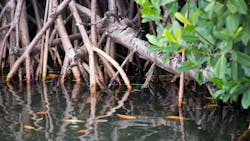Researchers quantify, model mangrove root hydrodynamics and erosion control
Mangrove vegetation, which grows naturally in subtropical shorelines, provides a wide range of ecosystem functions such as reducing coastal erosion, promoting biodiversity, and removing nitrogen, phosphorus and carbon dioxide.
These vital ecological functions are influenced by the water flow around the intricate mangrove roots, which create a complex energetic process that mixes up sediments and generates a depositional region behind the roots. How these mangrove roots interact with water flow is believed to be a key element in mitigating coastal erosion.
Accurately projecting hydrodynamic erosion and the essential amount of mangrove species has been a challenge for managers and restoration experts to forecast a successful component of project designs. That is because they need two critical pieces of information: characterization of the near-bed boundary layer of the mangrove roots and their effect on the mangrove root erosion; and a quantitative understanding of mangrove root erosion and the habitat requirements based on the optimal porosity.
Florida Atlantic University's Oscar M. Curet, Ph.D., an associate professor in the Department of Ocean and Mechanical Engineering within the College of Engineering and Computer Science, spearheaded the research with his co-authors, and are the first to quantify the optimal mangrove root hydrodynamic with a predictive model.
"Our data address the first informational need for global restoration communities with mangrove habitats and will bring about opportunities for interdisciplinary collaboration with the environmental and ecological engineering community," said Amirkhosro Kazemi, Ph.D., lead author and a post-doctoral research associate in the Department of Ocean and Mechanical Engineering. "Furthermore, understanding the hydrodynamics and scaling of this problem could contribute to the design and development of a bio-inspired mangrove-like system for coastal protection globally, especially in the subtropical regions where mangrove growth is possible."
For the study, published in Scientific Reports, (published by Nature) they used simplified mangrove root-type models with different porosities to investigate the impact of porosity on the initial motion of the sediments, which is critical to the evolution of shorelines, delta and lands. Their predictive model takes into account the mangrove roots' porosity and the near-bed turbulence effect.
The study identified the pivotal role of mangrove root porosity and provides insight into the sediment transport and erosion processes that govern the evolution of the shapes of shorelines. The field studies' wide spatiotemporal parameters could extend the results of the current research to successfully predict mangrove erosion outcomes on estuarine shorelines.
Characterizing the hydrodynamics of mangrove-like structures could explain the primary mechanisms for its resilience and by which mangrove roots can withstand high-energy fluid conditions. This information has the potential to improve future coastal infrastructure design with bio-mimetic mangrove-like structures.
The study also suggests that optimal porosity design of shoreline may add habitat flexibility to sites that are on the borderline of mangrove habitat suitability. This optimal porosity would affect increase in the critical velocity at which the sediment transport starts. The increment in the critical velocity has biological importance as it could potentially increase nutrients around the roots, increase energy dissipation to withstand high flow speeds, and control changes to the substrate bottom to facilitate the propagation of mangrove swamps.
"Roots that do not exceed the critical porosity for maximum energy dissipation may have adaptive benefits, for example, the ability to tolerate brackish waters in depositional environments," said Curet. "Increasing the mangrove species through pre-restoration grading can potentially increase the likelihood of decreasing erosion success, with a higher energy dissipation that increases the resistance of mangrove roots to the energy in tidal flows."
"This important research by Dr. Kazemi, professor Castillo and Dr. Curet contribute to fill a gap in understanding the near-bed flow and step forward accurate prediction of sediment transport in vegetated regions, which contributes to shaping them in nature," said Stella Batalama, Ph.D., dean, College of Engineering and Computer Science. "The optimal configuration porosity range and the critical velocity presented in this study can provide useful guidance for coastal managers restoring estuarine mangrove forests or planting mangroves as part of living shoreline stabilization."


